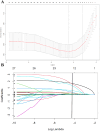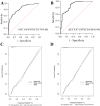Development and validation of a novel nomogram model for predicting delayed graft function in deceased donor kidney transplantation based on pre-transplant biopsies
- PMID: 38641807
- PMCID: PMC11031976
- DOI: 10.1186/s12882-024-03557-3
Development and validation of a novel nomogram model for predicting delayed graft function in deceased donor kidney transplantation based on pre-transplant biopsies
Erratum in
-
Correction: Development and validation of a novel nomogram model for predicting delayed graft function in deceased donor kidney transplantation based on pre-transplant biopsies.BMC Nephrol. 2024 Jun 18;25(1):199. doi: 10.1186/s12882-024-03641-8. BMC Nephrol. 2024. PMID: 38890598 Free PMC article. No abstract available.
Abstract
Background: Delayed graft function (DGF) is an important complication after kidney transplantation surgery. The present study aimed to develop and validate a nomogram for preoperative prediction of DGF on the basis of clinical and histological risk factors.
Methods: The prediction model was constructed in a development cohort comprising 492 kidney transplant recipients from May 2018 to December 2019. Data regarding donor and recipient characteristics, pre-transplantation biopsy results, and machine perfusion parameters were collected, and univariate analysis was performed. The least absolute shrinkage and selection operator regression model was used for variable selection. The prediction model was developed by multivariate logistic regression analysis and presented as a nomogram. An external validation cohort comprising 105 transplantation cases from January 2020 to April 2020 was included in the analysis.
Results: 266 donors were included in the development cohort, 458 kidneys (93.1%) were preserved by hypothermic machine perfusion (HMP), 96 (19.51%) of 492 recipients developed DGF. Twenty-eight variables measured before transplantation surgery were included in the LASSO regression model. The nomogram consisted of 12 variables from donor characteristics, pre-transplantation biopsy results and machine perfusion parameters. Internal and external validation showed good discrimination and calibration of the nomogram, with Area Under Curve (AUC) 0.83 (95%CI, 0.78-0.88) and 0.87 (95%CI, 0.80-0.94). Decision curve analysis demonstrated that the nomogram was clinically useful.
Conclusion: A DGF predicting nomogram was developed that incorporated donor characteristics, pre-transplantation biopsy results, and machine perfusion parameters. This nomogram can be conveniently used for preoperative individualized prediction of DGF in kidney transplant recipients.
Keywords: Delayed graft function; Kidney transplantation; LASSO regression; Nomogram; Pre-transplant biopsy.
© 2024. The Author(s).
Conflict of interest statement
The authors declare no competing interests.
Figures




References
MeSH terms
Grants and funding
LinkOut - more resources
Full Text Sources
Medical
Miscellaneous

